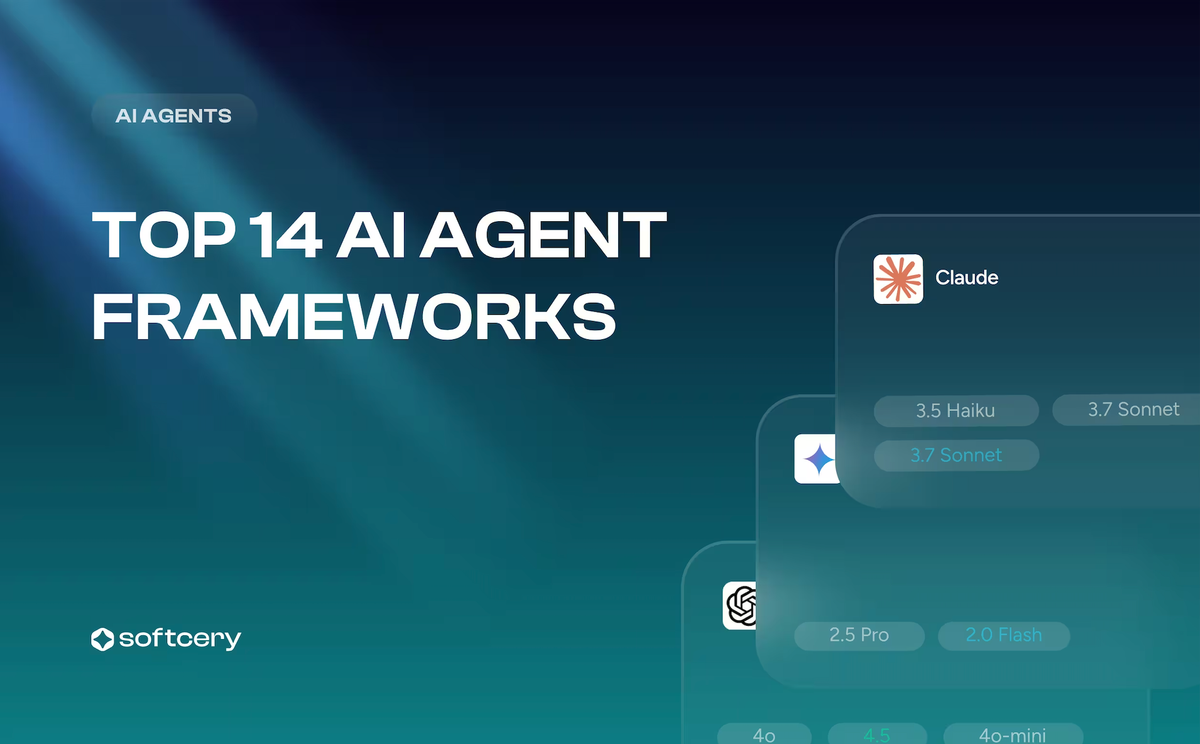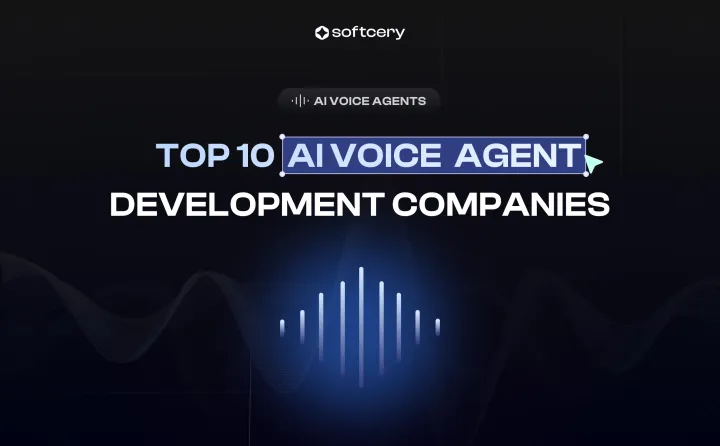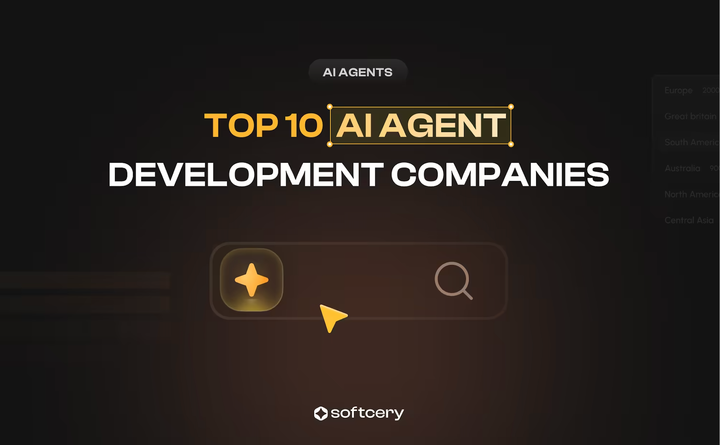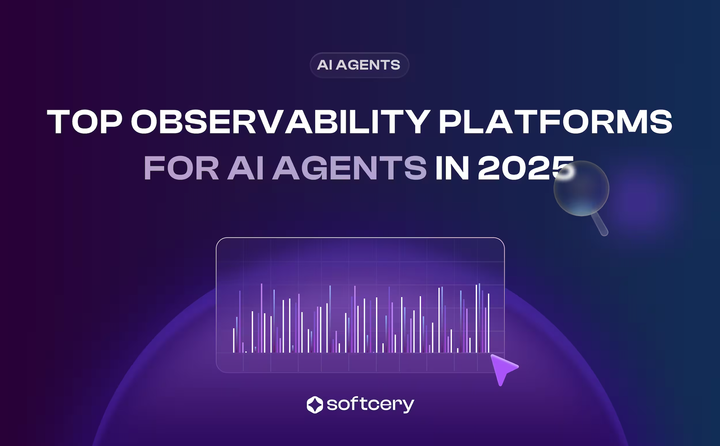
Top 14 AI Agent Frameworks of 2025: A Founder's Guide to Building Smarter Systems
Comprehensive comparison of AI agent frameworks, including LangGraph, OpenAI Agents SDK, and Agno, with insights on efficiency, cost per token, planning overhead, and business applications
In 2025, founders want practical answers: Which frameworks actually deliver scalability, control, and ROI? How can the company build a production-ready AI agents?
This guide takes a look at the 14 best AI agent frameworks of 2025, showing how companies actually use them in real projects. The insights come from Softcery's own experience bringing autonomous systems to life in real products.
Why AI Agents Matter for Modern Businesses
AI agents are the next evolution of automation capable of understanding goals, taking initiative, and learning from outcomes.
For businesses, AI agent integration means:
- Reducing repetitive human work (customer support, data analysis, onboarding).
- Accelerating operations (sales assistants, market research bots, workflow automation).
- Building entirely new product categories from AI copilots to self-learning ecosystems.
At Softcery, we’ve seen the transition firsthand. Clients who initially came for “chatbot integrations” now want multi-agent ecosystems that handle product support, data enrichment, and even customer retention autonomously.
But to build such systems, you need the right framework, the one that aligns with your technical stack, compliance needs, and long-term vision.
How We Evaluated Each AI Agent Framework
To make this guide useful, we’ve compared frameworks using five practical criteria founders and CTOs actually care about:
| Category | Feature | Description |
|---|---|---|
| Architecture | Modularity | Component separation, reusability, and composability |
| Agent Memory | Short-term context and long-term memory handling | |
| Tool Integration | Connecting to APIs, databases, and external services | |
| Planning Mechanisms | Reasoning methods (ReAct, Chain-of-Thought, graph-based) | |
| Orchestration | Single-agent, multi-agent, or distributed coordination | |
| Language Support | Primary Languages | Python, JS/TS, C#, Java, Rust, Go |
| SDK Quality | Type safety, IDE support, documentation | |
| Cross-Language | Integrates across different languages | |
| Extensibility | Plugins | Third-party extensions |
| Custom Tools | Adding custom functions and capabilities | |
| Connectors | Pre-built integrations or build-your-own | |
| Community Contributions | Templates, marketplace, and shared components | |
| Runtime Environment | Single-Agent | One agent handling tasks independently |
| Multi-Agent | Multiple agents collaborating | |
| Distributed | Agents as microservices | |
| Execution Model | Synchronous, asynchronous, event-driven, or streaming | |
| LLM Backend Support | Proprietary Models | OpenAI, Anthropic, Google |
| Open-Source Models | Meta Llama, Mistral, Deepseek | |
| Local Deployment | Ollama, LM Studio, vLLM, LocalAI | |
| Provider Agnostic | Swap LLM backends without code changes | |
| Fine-Tuning | Custom model training and adaptation | |
| Maturity & Community | Development Activity | Commits, maintainer responsiveness, roadmap clarity |
| Documentation | Guides, examples, tutorials | |
| Community Size | GitHub stars, Discord/Slack, forums | |
| Production Readiness | Enterprise deployments, case studies, stability | |
| Ecosystem | Libraries, tools, monitoring, integrations | |
| Additional Considerations | Observability | Logging, tracing, metrics, debugging tools |
| Guardrails | Safety features, validation, content filtering | |
| Deployment Options | Cloud, on-prem, edge, hybrid | |
| Pricing Model | Open-source, freemium, enterprise licensing | |
| Compliance | SOC 2, HIPAA, GDPR for regulated industries |
1. LangChain
Langchain has become one of the go-to tools for building advanced AI agents. Think of it as a framework that helps you connect prompts, APIs, and reasoning steps into one logical flow. It works seamlessly with models like OpenAI, Anthropic, or even local LLMs, which makes it a solid choice for companies that need both flexibility and control over their AI’s thinking process.
Pros:
Cons:
Tip from Softcery: Use LangChain when you need traceability and control. For instance, in agents that must explain their reasoning or follow structured workflows.
2. LangGraph
LangGraph builds on LangChain but adds a visual layer, representing workflows as directed graphs. This makes it easier to understand, debug, and scale multi-agent systems, giving teams a clear view of how each agent interacts and processes tasks.
Pros:
Cons:
Tip from Softcery: LangGraph is perfect for orchestrating complex workflows where both logic transparency and visual monitoring matter. Framework manages multiple customer-facing bots, ensuring that each agent’s actions are clear and trackable in real time.
3. CrewAI
CrewAI focuses on what it calls collaborative autonomy: agents that can delegate tasks, share updates, and coordinate results almost like a real team. It’s a powerful framework for experimenting with distributed intelligence: imagine an AI “crew” where one agent researches, another analyzes, and a third reports the outcome.
Pros:
Cons:
Tip from Softcery: CrewAI shines when your system depends on collaboration between specialized AI roles. You can use it in experimental research pipelines. For instance, during building the foundation for autonomous R&D assistants.
4. AutoGen (Microsoft Research)
AutoGen brings conversational orchestration to the table making agents debate and collaborate through dialogue. Therefore, the framework is ideal for simulation-heavy tasks, multi-agent reasoning experiments, or building advanced conversational flows.
Pros:
Cons:
Tip from Softcery: Use AutoGen when your project involves simulated reasoning or complex dialogue between agents. At Softcery, we find it invaluable for prototyping and experimentation, but less suited for production-ready systems where speed and simplicity are critical.
5. OpenAI Agents SDK
OpenAI Agents SDK, released in March 2025, is a minimalist Python framework designed for creating multi-agent workflows with robust tracing and guardrails. Despite its simplicity, it supports over 100 LLMs and comes with provider-agnostic compatibility, making it a versatile choice for a wide range of projects.
Pros:
Cons:
Tip from Softcery: OpenAI Agents SDK is ideal when safety, traceability, and lightweight workflows matter. Use it to build customer support automation systems where agents handle handoffs between specialized roles, maintain conversation history, and operate with guardrails to prevent inappropriate responses.
6. Google ADK (Agent Development Kit)
Google ADK (Agent Development Kit) is an open-source, code-first Python framework announced at Google Cloud NEXT 2025. Optimized for Gemini but model-agnostic, it simplifies building, evaluating, and deploying multi-agent systems with rich tool ecosystems and advanced capabilities like bidirectional audio and video streaming.
Pros:
Cons:
Tip from Softcery: Google ADK excels when building sophisticated multi-agent systems that need model flexibility and Google Cloud integration. At Softcery, we use it for projects requiring multimodal capabilities—especially voice and video interactions—while keeping the freedom to switch between LLM providers without changing the core architecture.
7. LlamaIndex
LlamaIndex acts as the “data brain” behind intelligent agents. It helps your AI not just access information but truly understand it through semantic indexing and persistent memory. In simple terms, it organizes and recalls data in a way that feels natural to how humans process context, while integrating smoothly with frameworks like LangChain or OpenDevin.
Pros:
Cons:
Softcery Insight: Use LlamaIndex when your product depends on deep context or dynamic knowledge retrieval. At Softcery, we often pair it with reasoning frameworks to build enterprise assistants that can search, remember, and respond using real, continuously updated business data.
8. Pydantic AI
Pydantic AI brings the FastAPI developer experience to AI agent frameworks. Built by the Pydantic team, it emphasizes type safety, durable execution, and smooth IDE support. It’s designed to help teams build agents that are reliable, maintainable, and interoperable with other systems, while handling long-running workflows or human-in-the-loop processes.
Pros:
Cons:
Smolagents is a minimalist, code-first AI agent framework from Hugging Face that enables developers to build powerful agents in just a few lines of code. Released in 2025, it prioritizes simplicity and speed, making it perfect for rapid prototyping without sacrificing capability. Pros: Cons: Tip from Softcery: Smolagents excels when speed and simplicity are priorities over complex orchestration. Use it for rapid prototyping and proof-of-concept work — validating AI agent ideas in hours, then migrating to more robust frameworks for production. Microsoft Semantic Kernel is a robust platform for building retrieval-based AI systems. It brings together search, summarization, and evaluation tools in one scalable framework, making it dependable for businesses that need consistent performance and actionable insights. Pros: Cons: Tip from Softcery: Microsoft Semantic Kernel shines when your system relies on RAG pipelines. Use it to build knowledge-focused assistants and customer support copilots prioritizing accuracy and scalability. Haystack is a solid platform for building retrieval-based AI systems. It combines search, summarization, and evaluation tools into one scalable framework, making it reliable for businesses that need consistent performance and insights. Pros: Cons: Tip from Softcery: Haystack excels when your product relies on large, structured internal data. At Softcery, we use it for building knowledge-focused assistants and customer support copilots, where accuracy, traceability, and scalability are key priorities. Agno, rebranded from Phidata, positions itself as one of the fastest agent frameworks available. It supports multi-modal data (text, images, audio, video), comes with a sleek Agent UI, and offers a robust control plane (AgentOS) for scalable, enterprise-grade deployments. Its minimal code design makes building complex agents surprisingly simple. Pros: Cons: Tip from Softcery: Agno shines when speed, multi-modal capabilities, and minimal code are priorities. At Softcery, we’ve used it to build web search agents that process text, analyze images, and generate video summaries — all in under 10 lines of code — while giving non-technical users an elegant interface to interact with the agent. NVIDIA NeMo is an enterprise-ready AI agent platform announced for general availability in April 2025. It manages the complete AI agent lifecycle with modular, interoperable microservices for data curation, model customization, deployment, and optimization, designed specifically for production enterprise environments. Pros: Cons: Tip from Softcery: NVIDIA NeMo excels for enterprise clients who need production-grade AI agent infrastructure with complete lifecycle management. We recommend it for clients with compliance requirements, high-volume deployments, or complex multi-agent systems demanding enterprise security, monitoring, and vendor support. The integrated approach reduces operational complexity compared to assembling separate tools. Composio acts as a “skill layer” for AI agents, letting them reliably interact with over 250 tools and 500 apps. It works with 25+ agent frameworks, manages authentication securely, and provides observability so teams can track agent interactions with external systems. Think of it as the bridge between your AI workflows and the real-world applications they need to control. Pros: Cons: Tip from Softcery: Composio is perfect when your agents need to work in the real world. At Softcery, we’ve used it to connect CrewAI-based marketing automation agents to Gmail, Slack, HubSpot, and Google Sheets, while managing OAuth authentication securely and reliably. In 2025, the focus is shifting from standalone models to systems that think, act, and integrate intelligently. Teams are starting to expect more than raw accuracy: agents must operate efficiently, respect data privacy, adapt in real time, and collaborate seamlessly with humans and other AI models. From modular architectures to multi-modal reasoning, the next wave of agent development is all about flexibility, reliability, and measurable business impact. Here are the trends shaping the way founders and teams will build smarter AI systems this year: When evaluating or comparing AI agent frameworks, most teams focus on model accuracy or response quality. That’s a mistake. Many
AI agent prototypes fail in production
because real-world performance isn’t just about model accuracy, but also about how efficiently, safely, and consistently your agents operate under production constraints.
Benchmarking agents in 2025 means shifting from LLM-centric metrics to systemic performance metrics. You’re not just testing a model; you’re testing a distributed ecosystem of reasoning, retrieval, and action. Recent benchmarking shows meaningful differences in efficiency, cost, and planning overhead: Token pricing highlights for different AI models: Frameworks handle token usage differently. LangGraph’s graph-based approach minimises redundant context passing between agents, while conversation-driven frameworks like AutoGen may accumulate larger context windows. Agentic workflows add overhead depending on complexity: This directly impacts both latency and cost. Frameworks with efficient orchestration, like LangGraph and Pydantic AI, reduce unnecessary calls through better state management, improving overall system performance. The truth is, there’s no universal “best” AI agent framework, only the one that best fits your strategic vision, existing stack, and team capabilities. Your choice is an architectural decision that will shape how your AI infrastructure evolves over time. To have a clear understanding of your AI project requirenments, ask yourself a few critical questions: Don’t chase frameworks — chase clarity. Start with your agentic use case, define what “autonomy” means in your context, and choose a framework that aligns with your existing tech ecosystem or assign this task to a team of professionals. From our experience, blending multiple tools for the best production-ready solution usually worth the result. For example, LangChain for logic, LlamaIndex for memory, and LangGraph for orchestration. If you’re exploring how agent frameworks can power your next product, it’s not about picking one; it’s about designing an ecosystem that scales with you. 1. Which AI agent framework should I start with for my product or MVP? For an MVP, speed and simplicity are key. Frameworks like OpenAI Agents SDK, LangChain, or CrewAI let you get a working agent quickly, validate your idea, and collect user feedback without spending weeks on setup. For a full product beyond the MVP, you’ll need to think about scalability, observability, and multi-agent coordination—frameworks like LangGraph, Pydantic AI, or Haystack are better suited for that. A smart approach is to start lightweight for your MVP and gradually layer in production-grade features as your product grows. 2. How do I choose between frameworks for MVP vs production-ready products? The key is balancing speed, flexibility, and reliability. MVP frameworks let you prototype fast, test hypotheses, and iterate quickly—OpenAI Agents SDK or LangChain are great examples. Production frameworks like LangGraph or Pydantic AI focus on observability, type safety, and robust multi-agent workflows, which are crucial once you scale. Many founders start with an MVP framework to validate the idea, then migrate or extend to production-grade frameworks to handle higher loads, compliance, and long-term maintainability. 3. Do I need multiple frameworks for different use cases? Often, yes. One framework might be great for reasoning (LangChain) while another excels at context memory (LlamaIndex). Softcery usually combines tools: LangChain for structured workflows, LlamaIndex for knowledge management, and LangGraph for orchestration. Don’t force a single framework to do everything—it’s more efficient to mix and match. 4. How much technical expertise does my team need? The answer depends on the framework you have chosen. Python-heavy frameworks like Pydantic AI or AutoGen require experienced developers, while SDKs like OpenAI Agents SDK are lighter and easier for small teams. For non-technical founders, early MVPs can still be built with minimal coding using pre-built connectors or even no-code layers like Composio. 5. How do I measure if my AI agent is actually “working”? Focus on real-world outcomes: task success rate, response latency, context retention, and cost efficiency. Ask yourself: “Is this agent reducing human work? Is it saving time or money? Can it handle the expected load reliably?” This is how you measure ROI in production—and avoid building an impressive but useless bot.9. Smolagents (Hugging Face)
10. Microsoft Semantic Kernel
11. Haystack
12. Agno (formerly Phidata)
13. NVIDIA NeMo
14. Composio (Tool Integration Platform)
AI Agent Development Trends to Watch in 2025
Benchmarking
We recommend evaluating each framework through five key dimensions:
Metric
Description
Why It’s Important
Task Success Rate
% of completed tasks without human correction
Reflects autonomy
Response Latency
Average time per action
Affects user experience
Context Retention
Ability to maintain state across steps
Critical for reasoning tasks
Resource Efficiency
Compute and API cost per run
Impacts scalability
Integration Overhead
Setup complexity
Determines time to market
Framework Performance (2025 Data)
Cost & Token Efficiency
Planning Steps & Decision Quality
Final Thoughts: Choosing the Right AI Agent Framework
Category
Subcategory / Use Case
Recommended Frameworks
By Use Case
RAG & Knowledge Systems
LlamaIndex, Haystack
Multi-Agent Collaboration
CrewAI, AutoGen, LangGraph, Google ADK
Enterprise Production
NVIDIA NeMo, Microsoft Semantic Kernel, Haystack, AutoGen
Fast Prototyping
Smolagents, OpenAI Agents SDK, Agno, CrewAI
Maximum Control
LangGraph, Haystack
Type Safety
Pydantic AI
Tool Integration
Composio (+ any framework)
By Architecture
Graph-Based
LangGraph
Conversation-Based
AutoGen
Role-Based
CrewAI
Pipeline-Based
Haystack
Lightweight
Smolagents, OpenAI Agents SDK, Agno
By Team Size
Startups / SMBs
Smolagents, LangChain, CrewAI, OpenAI Agents SDK
Mid-Size Companies
Google ADK, LangGraph, LlamaIndex, Pydantic AI
Enterprise
NVIDIA NeMo, Microsoft Semantic Kernel, Haystack Enterprise, AutoGen
Softcery’s Advice for Founders
FAQs



